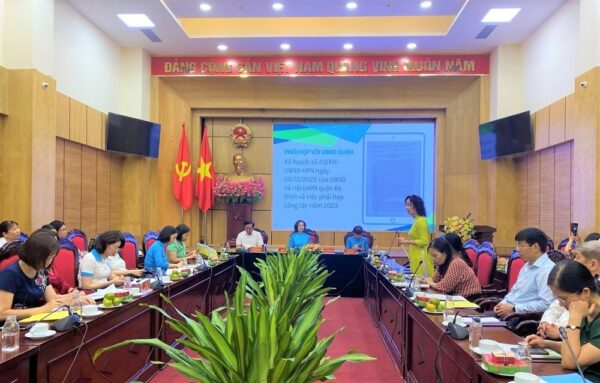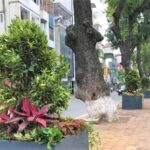After nearly 30 years of constructing cultural models, Ba Dinh district in Hanoi has achieved numerous significant outcomes, thereby enhancing the material and spiritual quality of life for its residents.
From typical models
Six months into the implementation of the “Model Residential Group” initiative across six wards in Ba Dinh district, notable changes have taken place. The focal points in cultural neighborhoods within these wards have been completed, aligning with the practical needs of each area.
A notable example is in Kim Ma Ward, where a sophisticated commercial boulevard is intertwined with greenery, trees, and households contributing to the harmonious cultivation of plants. They also organize their parked vehicles neatly, and shops commit to responsibly caring for and protecting greenery, as well as maintaining cleanliness in front of their homes and stores. Additionally, they pledge to guide organized parking and uphold civility in commercial transactions.

A Street Corner in Kim Ma Ward
In Thanh Cong Ward, the model introduces community playgrounds, communal flower houses, and safe staircases in collective living areas. The initiative aligns with the Party Committee’s specialized resolution, working hand-in-hand with the authorities to execute plans for constructing exemplary cultural Residential Groups. The focus is on addressing violations encroaching on communal play spaces, ensuring a pleasant environment for recreational activities for the residents. Activities in community centers are organized with clear regulations and rules, and the play areas feature posted guidelines for everyone’s awareness and protection.
In Lieu Giai Ward, the model introduces a security-friendly alley with a camera system and camera heads to ensure security in the alleys. Families have identified three secure alleys so far. In Ngoc Khanh Ward, a flower-adorned street with elevated flags and decorative flower pots along Pham Huy Thong Street enhances the scenic beauty around Ngoc Khanh Lake. This approach limits encroachments on sidewalks for unauthorized business activities and illegal parking. The cafes around the lake are encouraged to adopt a refined and coordinated design, preparing to serve the pedestrian street model around Ngoc Khanh Lake.

The Houses by Truc Bach Lake
In Truc Bach Ward, the vibrant flag display along the culinary pedestrian street of Dao Ngoc – Ngu Xa has successfully propelled social participation in adorning 100% of flagpoles along the culinary streets. This initiative embellishes storefronts, ensuring aesthetic appeal. It mobilizes households engaged in business to commit to the effective implementation of food safety and publicly posts behavior regulations, complete with QR codes.
In Quan Thanh Ward, the project “Ensuring Security and Order – Environmental Hygiene – Blooming Flowers in the Street” adorns flowerpots on Phan Dinh Phung Street, enhancing the street’s landscape while reducing unauthorized car encroachments on sidewalks.
Implementation experience
Ms. Dinh Thi Phuong Lien, Chairwoman of the Ba Dinh District Women’s Union, revealed that the remaining 8 wards have chosen 8 Cultural Residential Groups to implement the model. Notably, Giang Vo Ward has introduced a model of an exemplary Cultural Residential Group, implementing the Public Code of Conduct at Residential Group No. 3. This includes a refined and safe civilized street with 21 tree trunks, 235 meters of painted walls, 50 buried pillars, and 115 meters of chains to prevent unauthorized cars. Additionally, there are 52 flag bases, flagpoles, and flag leaves for hanging during festive occasions, along with posted behavior rules in the area around Giang Vo Lake.
The total socialized funding for these 8 exemplary model projects, exemplifying beautiful public conduct, amounts to over VND 348 million. This collaborative effort involves the participation of officials, party members, and citizens, with a focus on the core force of women union members across the wards.

Ms. Dinh Thi Phuong Lien, Chairwoman of the Ba Dinh District Women’s Union, shared insights at the conference.
According to the Chairwoman of the Ba Dinh District Women’s Union, at the end of 2022, the district Women’s Union received guidance from the City Women’s Union, taking responsibility as a core force in constructing a model neighborhood focused on implementing the public Code of Conduct.
Upon receiving the model, the district Women’s Union reported to the District Party Committee to seek direction. Subsequently, they collaborated with the District People’s Committee to incorporate it into the focal tasks of the 2023 coordination plan between the District Women’s Union and the District People’s Committee. They then executed the collaboration plan with six wards that had a long-standing record of achieving the title of Cultural Residential Group, closely associated with the “Civilized branch, friendly members” model. The goal was to implement the model, with a specific emphasis on aligning it with the district’s political tasks.
After reviewing, evaluating, and selecting, they organized discussions to establish criteria. Subsequently, they coordinated with the Party, government, and political system of the six wards to hold community meetings at the Residential Groups. They conducted meetings with women’s unions to disseminate information and discuss the construction of the model neighborhood focused on implementing public behavior rules, urging them to commit to fulfilling the criteria. They selected Kim Ma Ward, Residential Group No. 9, as the initial point, aiming to develop step-by-step guidelines for the process.
After nearly six months of implementation, the district Women’s Union drew some experiential lessons, such as choosing areas where the model could be easily implemented to attract, persuade, and mobilize support before gradually tackling more challenging areas. They proceeded cautiously, emphasizing the guiding principle of “Harnessing the people’s strength to build a better life for the people.” The leadership roles and directives of leaders, from the Secretary and Chairperson to the heads of Residential Groups, were affirmed at every step.
Importantly, there was a need for the synchronized involvement of the entire grassroots political system. They emphasized skillful mobilization and active community participation to socialize the construction of projects and specific tasks in implementing the model of a model cultural residential group.

